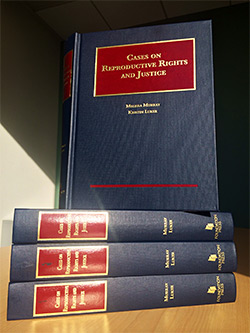
The Berkeley Law Center on Reproductive Rights and Justice (CRRJ) today announced the release of the first legal textbook that covers the wide range of laws and policies that regulate sex, reproduction, bodies, and families. Cases on Reproductive Rights and Justice (Foundation Press) underscores the importance of these laws and regulations in legal education and everyday life.
Co-authors Melissa Murray, a Berkeley Law professor and faculty director of CRRJ, and Kristin Luker, a Berkeley Law and Sociology professor and CRRJ co-founder, collected and edited cases and secondary materials for this comprehensive volume. The book provides students and teachers with a tool for engaging in a substantial and thoughtful analysis of the various ways in which law, culture, and politics intersect with the regulation of reproduction.
The casebook is being published at an important juncture for legal education. In recent years, pressure from the constricted legal job market has prompted some law schools to limit elective courses. ‘Bread and butter’ courses—such as corporate law and trial practice—are viewed as necessary for making students “practice-ready,” Murray said. This dynamic means that reproductive rights and justice courses are fairly rare at law schools across the nation.
The lack of a casebook has also contributed to the paucity of reproductive rights and justice offerings. Those interested in teaching the topic often have been dissuaded by the prospect of compiling their own materials—a herculean enterprise for even the most enthusiastic instructor, Murray said. Despite these limitations, a 2014 survey found student interest in these courses on the rise, as issues—such as fertility treatments, contraceptive coverage under the Affordable Care Act, and abortion restrictions—continue to capture media attention. The new casebook responds to these topical concerns, while filling a critical pedagogical gap that has existed in the academy for well over a generation.
Importantly, the casebook is not limited to abortion—perhaps the most obvious reproductive rights issue in public debate. “We wanted to broaden the framework to really capture how reproduction is regulated for all people,” Murray said. Accordingly, the new casebook covers such topics as the policing of sex, criminalization of drug-addicted pregnant women, and coercive sterilizations of women in prison.
This expanded focus is appropriate, said Luker, an expert on the regulation of sex who advised the Clinton Administration on teenage pregnancy: “Reproductive justice can be found anywhere—it is hiding in plain sight. Focusing too narrowly on the right of privacy excludes a whole range of situations a person goes through in his or her lifetime.”

Although there has been a flurry of restrictions on women’s access to reproductive healthcare in recent years, the casebook is not intended as a response to the shifting contours of the abortion debate. “If anything, it is a response to a culture and politics that historically and modernly regulates sex, reproduction, and family life, in ways that are at once subtle and obvious, prosaic and profound,” Murray said.
Executive Editor and center Director Jill E. Adams ’06 said that the value of the book stems not only from the breadth of the topics addressed, but also from the depth of the analysis. “The letter of the law reveals only a sliver of the picture,” Adams said. “To truly understand the impact of regulations and restrictions controlling these most intimate realms of our lives, we must consider the beliefs motivating them, the institutions supporting them, and the communities harmed most by them.” She said the authors paint a complete picture of these dynamics through their thoughtful selection of cases, statutes, and articles that push readers “past the written laws into the lived realities.”
As such, law students Eliza Duggan ’16, and Kate Meyer ’16, who provided research assistance for the co-authors, are enthusiastic about the book and its future use. Both students are interested in pursuing careers in the field and are confident that the book will provide future advocates with the necessary tools to address these complicated issues. “I learned how deeply entrenched notions of sex, sexuality, gender, race, and class have informed which reproductive choices we have valued in our society and which we have systematically regulated or criminalized,” Meyer said.
“This material has deepened and will continue to further my knowledge and understanding of this area of law and will not only make me better in my practice,” Duggan said, “but will also improve my connections with my clients and other areas of my life.” According to Duggan, the book will help her “become the most effective, compassionate, and educated lawyer that I can be.”
Luker emphasized that society “puts a lot of faith” in the thinking of lawyers. As such, she and Murray agreed that future lawyers should be exposed as broadly as possible to crucial issues surrounding reproduction and sexuality.
“By raising these questions in the context of the law school curriculum, we’re preparing our students to think empathically and critically and to engage thoughtfully on these issues,” Murray said. “Those skills – as much as deposition training and negotiations—will prepare them to confront these questions in legal practice and in their own lives.”